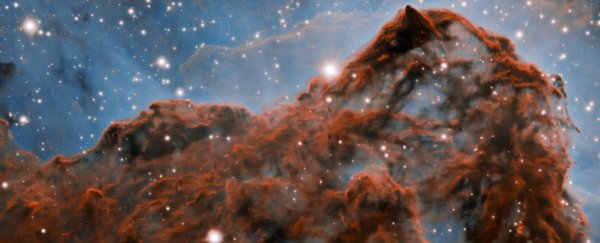Astronomers have obtained the highest resolution near-infrared images yet of the Carina Nebula, a thick cloud of dust and gas in which stars are actively forming.
The newly obtained images, sourced with the Gemini South telescope in Chile, are incredible to look at. They are also useful for understanding stellar nurseries and stellar birth, and are somewhat of a preview of the kinds of images we can expect when the whiz-bang James Webb Space Telescope finally takes to the skies.
"The results are stunning," said physicist and astronomer Patrick Hartigan of Rice University.
"We see a wealth of detail never observed before along the edge of the cloud, including a long series of parallel ridges that may be produced by a magnetic field, a remarkable almost perfectly smooth sine wave and fragments at the top that appear to be in the process of being sheared off the cloud by a strong wind."
Stellar birth is a fascinating process, but it can't take place just anywhere. You need a thick cloud of gas and dust, rich in molecular hydrogen and so dense, it contains regions that gravitationally collapse under their own mass.
As those knots collapse, any rotation thereof becomes amplified under the conservation of angular momentum. This creates a rotating disc of material feeding into the protostar (and which eventually may go on to form planets after the star formation process is complete).
So, the best sites of star formation are the densest and dustiest. These interstellar clouds appear opaque, like dark voids against the shimmering backdrop of stars in optical wavelengths. Which makes them a bit of an Achilles heel for the Hubble Space Telescope.
"Hubble operates at optical and ultraviolet wavelengths that are blocked by dust in star-forming regions like these," Hartigan said.
But light in infrared and near-infrared wavelengths can penetrate the thick dust, letting astronomers peer inside these enigmatic clouds. That's where instruments like Gemini South have an advantage over Hubble. But they also have a disadvantage. Hubble is in space. Gemini South is on Earth, within the bubble of our planet's atmosphere.
Atmospheric turbulence distorts and splits light from far away - it's why stars appear to twinkle when you look up at the night sky. That's a problem for ground-based astronomy, and over the years, different techniques have been applied to correct for it.
It used to be that the distortion effects had to be removed when the images were being processed, after the observations had already been taken. Advances in technology, however, have allowed for what we call adaptive optics, which corrects for atmospheric turbulence as the observations are underway.
The Gemini South Adaptive Optics Imager consists of five lasers; these are beamed at the sky to project artificial "guide stars" that are measured to correct the effect of atmospheric turbulence.
Using this technology, Hartigan and his team were able to obtain images of the Carina Nebula in a resolution 10 times higher than images taken without adaptive optics, and about twice as sharp as Hubble images at this wavelength. And the images revealed new details of the interaction between a cloud of dust and gas, and a cluster of young massive stars nearby.
The section of cloud is known as the Western Wall, and the radiation blasting off the hot young stars is ionising the hydrogen, causing it to glow with infrared light. The ultraviolet radiation from the stars is also causing the outer layer of hydrogen to evaporate.
Using different filters, the team were able to obtain separate images of the hydrogen at the cloud's surface and the evaporating hydrogen.
"This region is probably the best example in the sky of an irradiated interface," Hartigan said. "The new images of it are so much sharper than anything we've previously seen. They provide the clearest view to date of how massive young stars affect their surroundings and influence star and planet formation."
The James Webb Space Telescope, when it launches in about a year's time (touch wood), will primarily observe in the infrared and near-infrared; so this image, the researchers said, is a bit of a sneak peek into what we can expect to see in the future.
But it also reveals the power of adaptive optics as a complement to round out or observing capabilities.
"Structures like the Western Wall are going to be rich hunting grounds for both Webb and ground-based telescopes with adaptive optics like Gemini South," Hartigan said. "Each will pierce the dust shrouds and reveal new information about the birth of stars."
You can download a high-resolution version of the image here. The research has been published in The Astrophysical Journal Letters.
